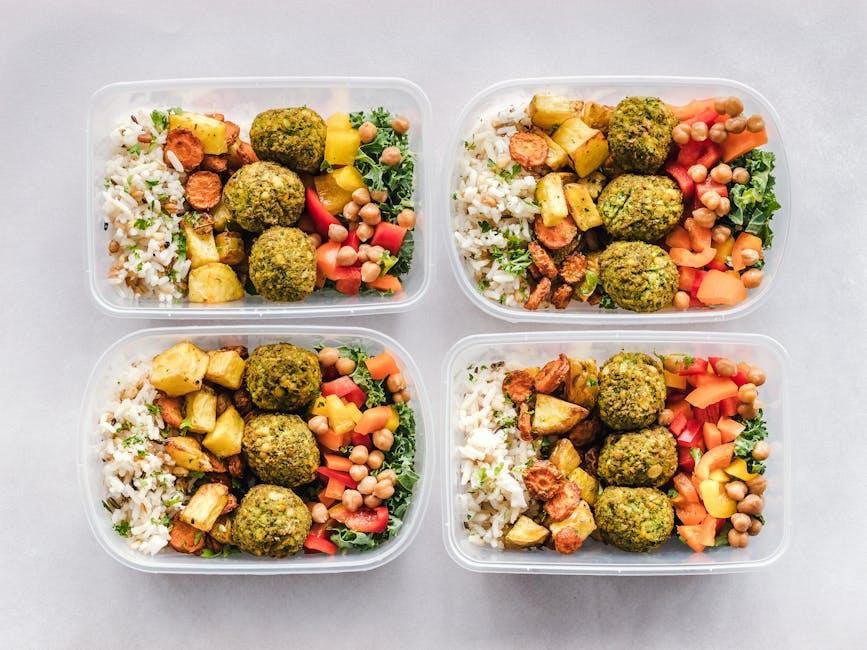In the ever-evolving landscape of dietary choices, where health trends come and go like passing seasons, the quest for meals that are both flavorful and nutritious can often feel like a delicate dance. As we navigate the bustling aisles of grocery stores filled with vibrant produce and enticing snacks, the challenge lies not merely in picking ingredients that boast health benefits but also in creating dishes that delight the palate. This article embarks on a culinary journey to explore the art of balancing flavor and nutrition in every meal. By blending the science of healthy eating with the joy of cooking, we’ll uncover practical tips, inventive recipes, and a fresh viewpoint on how to nourish both body and soul.Whether you’re a seasoned home cook or just starting your culinary adventures, discover how to transform simple ingredients into extraordinary meals that celebrate health and taste in perfect harmony.
Exploring the Foundations of Flavorful Nutrition
To truly embrace a fulfilling culinary experience, it’s essential to recognise that flavor and nutrition are not opposing forces but rather complementary elements in a well-crafted meal. Vibrant flavors frequently enough stem from a rich palette of fresh ingredients, and understanding these foundational components allows us to craft dishes that tantalize the taste buds while providing essential nutrients. Consider integrating a variety of herbs and spices; not only do they elevate the taste, but many also offer health benefits, enhancing both the sensory and nutritional value of your meals. Here are some ingredients to consider:
- Fresh herbs: Basil,cilantro,and parsley add brightness and depth.
- Whole grains: Quinoa, farro, and brown rice provide fiber and energy.
- Colorful vegetables: Bell peppers,carrots,and spinach not only add texture but also a range of antioxidants.
To illustrate the balance of flavor and nutrition in meals, it’s helpful to think of a simple framework. Visualize a plate structured on the principles of variety and balance, where each section contributes uniquely to the overall composition. Below is a table that showcases this concept, presenting a typical meal and its nutrient components:
| Meal Component | Flavor Profile | nutritional Benefit |
|---|---|---|
| Grilled Chicken | Smoky, savory | Lean protein, low in fat |
| Quinoa Salad | Nuts and citrus | Complete protein, fiber |
| Roasted Broccoli | Earthy, umami | Vitamins C and K, antioxidants |

Essential Ingredients for Delicious Yet Nutritious Meals
Creating meals that skillfully blend flavor and nutrition requires a thoughtful selection of ingredients. Start with whole grains like quinoa and brown rice, which not only provide essential fiber but also offer a hearty base for any dish. Incorporate an array of colorful vegetables, such as spinach, bell peppers, and carrots, that deliver vital vitamins and antioxidants while adding visual appeal.Don’t forget about lean proteins like chicken breast, beans, or tofu, which are crucial for muscle repair and overall health without overwhelming the palate.
A hint of healthy fats, such as avocados or olive oil, can elevate flavor while promoting heart health. Experiment with herbs and spices to introduce new layers of taste without extra calories; options like fresh basil, rosemary, and cumin can transform a simple dish into a culinary masterpiece. To make meal planning easier, here’s a simple guide to pairing these ingredients:
| Ingredient Type | Examples | Nutritional Benefit |
|---|---|---|
| Whole Grains | quinoa, Brown Rice | High in fiber and B vitamins |
| Vegetables | Spinach, Carrots | Rich in vitamins A and C |
| Lean Proteins | Chicken, Tofu | Supports muscle growth and repair |
| Healthy Fats | Avocado, Olive Oil | Promotes heart health |
| Herbs & Spices | Basil, Cumin | Add flavor with antioxidants |

Techniques to Enhance Taste without Compromising Health
Enhancing flavor while maintaining health is an art that can transform your meals into flavorful, nutritious experiences.One of the simplest ways to achieve this is by using fresh herbs and spices. These not only add depth and complexity to dishes but also come packed with antioxidants and anti-inflammatory properties. Experiment with flavors like basil, cilantro, or smoked paprika to elevate a dish without excess salt or sugar, which can detract from its health benefits. Another technique is to incorporate acidic elements such as lemon juice or vinegar; these can brighten flavors and create a more satisfying taste profile without adding calories.
Texture also plays a crucial role in enhancing taste without compromising health. Incorporating a variety of crunchy vegetables, such as bell peppers or carrots, can make dishes feel more considerable and satisfying.Pairing ingredients wisely can create a delightful contrast that excites the palate. for instance, serving creamy avocados with crisp radishes or adding toasted nuts to salads not only enhances the taste but also boosts the nutritional value.Don’t shy away from using healthy cooking methods like roasting or grilling, which can bring out natural sweetness and flavors in ingredients while reducing the need for unhealthy fats.

Meal Planning strategies for Balanced Eating Every Day
To achieve daily balance in your meals, consider pre-planning to streamline your grocery shopping and cooking process. Start with a weekly menu that caters to both nutrition and taste. Incorporate a variety of food groups to ensure your meals are rich in essential vitamins and minerals. Here are some effective strategies to keep in mind:
- Diverse Ingredients: Experiment with different vegetables, proteins, and grains each week to keep meals exciting.
- Meal Prep: Dedicate a day to batch cooking and portioning out meals to save time and reduce daily decision fatigue.
- balance Macronutrients: Aim for a combination of carbohydrates, proteins, and healthy fats in every meal to promote sustained energy.
- mindful Flavoring: Use herbs and spices for depth without excess calories—think fresh cilantro, rosemary, or chili powder.
Implementing portion control is another vital aspect of maintaining balance,and utilizing simple tables can help visualize daily intake. Here’s a straightforward example:
| Food Group | Serving Size | Daily Advice |
|---|---|---|
| Fruits | 1 Medium Fruit | 2 Servings |
| Vegetables | 1 Cup Raw | 3 Servings |
| Whole Grains | 1 Slice Bread | 6 Servings |
| Lean Proteins | 3 Ounces Cooked | 5 Servings |
| Dairy | 1 cup Milk | 2 Servings |
These strategies and simple guidelines can transform the way you approach your daily meals, ensuring that nutrition and flavor harmoniously coexist on your plate.
Key Takeaways
as we wrap up our exploration of balancing flavor and nutrition in every meal, it’s clear that achieving this harmony is not just a culinary challenge, but a rewarding journey. By embracing fresh ingredients, experimenting with spices, and being mindful of portion sizes, you can create dishes that not only tantalize your taste buds but also nourish your body. Remember, it’s about striking that perfect chord—where health meets indulgence. So,as you step into your kitchen,let your creativity flourish. Each meal is an chance to craft delightful experiences that honour both your palate and your well-being. Happy cooking!




